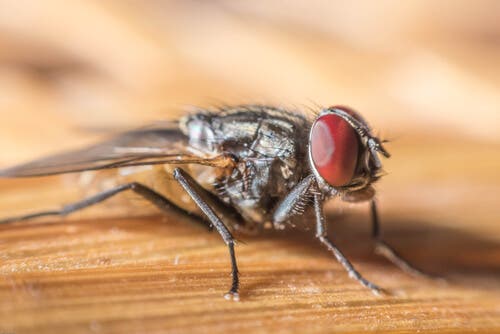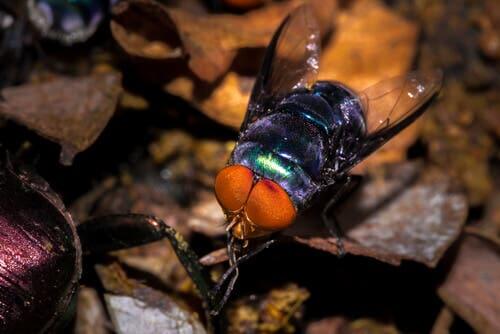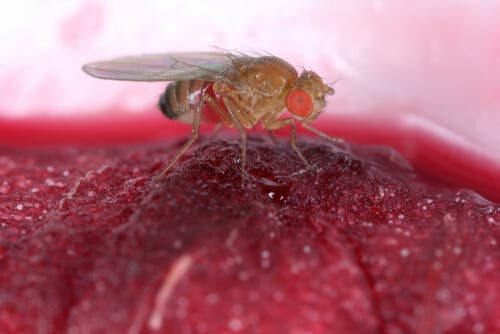9 Species of Flies

Flies can be very annoying. They can appear anywhere and we usually associate them with dirty spaces. Some species of flies are more common than others. However, you need to be careful with the species that transmit diseases. We’ll tell you more below:
What species of flies are there?
Within the dipteran family, the most “famous” species is the house fly. All members of this species live around 30 days and complete a metamorphosis cycle: egg, larva, pupa, and adult. Here’s a summary of different species of flies:
1. Horse-fly
This fly can be up to an inch long. They are dark brown in color and have large green or black eyes. However, the eyes are contiguous in males and separated in females. Horseflies are more active in daylight hours. They attack livestock and can cause weight loss in animals.
As for reproduction, these flies mate in the air and on the ground. Then, the females deposit the eggs in a humid area or in the water. These eggs hatch after seven days.
2. The Attic fly
This species flies slowly in a cluster. As a result, they are also called the common cluster fly. They are drawn by light or heat so they choose warm places to hibernate in winter. These flies can reach up to 0.5 inches in length. When they are at rest, their wings cover their entire body. Their wings are dark gray with olive green and brown areas.
3. Bluebottle fly
This fly mainly appears in putrefied or decomposing substances, such as meat or cheese. They also develop around the carcasses of birds or rodents. The bluebottle fly measures up to 0.5 inches in length and their bodies are metallic blue.

4. Housefly
This type of insect is attracted to different types of food. They prefer humid places or being near decomposing plant material. At night, they rest near food.
The larvae are white and don’t have legs initially. In fact, they take up to 60 days to mature. Adults are up to 0.3 inches in length. They also have a gray thorax and a yellow abdomen. Additionally, their wings are slightly tapered.
5. Fruit fly
This is one of the most common species of flies in homes during the summer. They breed in areas where there are residues of fermentation, such as fruits and vegetables. In addition, they breed near covered drains or dirty dishes. Fruit flies are very small – only 0.1 inches in length. Their bodies are yellow and their eyes are red.
6. Drain flies
This small fly is only 0.07 inches long. You can find these flies in sewers, toilets, or standing water. They also spend a long time stationary, and fly very slowly. Also, these flies feed on organic matter they extract from the sediments.
This species has a tan or black body. In addition, their wings are covered in hair. In terms of their development, their metamorphosis process takes around 60 days for them to become adults.
7. Vinegar flies
This fly reproduces in fermented residues because the larvae feed on bacteria and yeast. They have a bright yellow body and red eyes. This species’ scientific name is Drosophila melanogaster and they’re only 0.1 inches long. They only live a maximum of two weeks.

8. Lesser housefly
This insect’s preferred habitat are areas where there’s decomposing semi-liquid organic matter. They resemble houseflies, although they’re smaller. In fact, they only reach up to 0.2 inches long in their adult stage
This fly can transmit eye disease to cattle and humans. However, they’re easy to identify due to their gray and black body and red eyes.
9. Flesh fly
Experts consider this fly a significant disseminator of pathogens. This is because they appear where there is dead meat. As a result, the larvae develop and live in decomposing organic materials.
Additionally, this fly is large in relation to other species. – up to 0.8 inches in length. This species also has a striking metallic gray body and dark-spotted abdomen.
All cited sources were thoroughly reviewed by our team to ensure their quality, reliability, currency, and validity. The bibliography of this article was considered reliable and of academic or scientific accuracy.
- García, B. (2013) Dípteros (Insecta: Diptera) sarcosaprófagos de Gómez Palacio, Durango. (Tesis de grado, Universidad Autónoma Agraria).
- Otero-Moreno, D., Peña-Rangel, M. T., & Riesgo-Escovar, J. R. (2016). Crecimiento y Metabolismo: La regulación y la vía de la Insulina desde la Mosca de la Fruta, Drosophila melanogaster. TIP. Revista especializada en ciencias químico-biológicas, 19(2), 116-126.